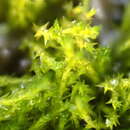Comments
provided by eFloras
Archidium alternifolium is widely distributed in the southeastern region of the United States. It is closely related to A. tenerrimum, which differs by much shorter and wider lamina cells and smooth margins of perichaetial leaves. The filiform rhizoidal gemmae are difficult to find, as most collections of the species have abundant uniseriate algae growing among the rhizoids. Recently, material referred to A. alternifolium was collected in Santa Cruz County, California. The collection is somewhat different than typical material, however, as it has strongly subulate perichaetial leaves and much shorter lamina cells, with those in mid-leaf being somewhat irregular in shape and size. Only a few plants were found, and more material is needed to determine their status. However, collections identified as A. donnellii and A. hallii have recently been reported from the Pacific coast of Baja California, so the presence of A. alternifolium is not completely unexpected.
- license
- cc-by-nc-sa-3.0
- copyright
- Missouri Botanical Garden, 4344 Shaw Boulevard, St. Louis, MO, 63110 USA
Description
provided by eFloras
Plants 2-20 mm, perennial, gregarious or in dense short turfs, green or yellow-green. Stems simple to branched by several sterile innovations to 15 mm, becoming prostrate with age. Stem leaves erect to erect-spreading, ovate-lanceolate to lanceolate or triangular, acuminate to subulate, 0.5-2.5 mm; costa strong, percurrent to short-excurrent, sometimes long-excurrent in long subulate tip; laminal margins plane, smooth or finely serrulate distally; median laminal cells rhomboidal to linear-rhomboidal, 5-15:1, 45-160 × 8-14 µm, becoming somewhat shorter distally, proximal cells rectangular, 3-8:1, 45-90 × 9-18 µm, cells in alar region short-rectangular to quadrate, 1-2:1, in 2-3 rows extending from 3-10 cells distally from base along margin; leaves of innovations similar to stem leaves but smaller, gradually reduced proximally. Perichaetial leaves erect, concave, sometimes flexuose, ovate-lanceolate, acuminate to strongly subulate, laminal cells similar to stem leaves except proximal and alar cells long-rectangular, 6-10:1, 90-140 × 14-20 µm, distinctly hyaline, at least in alar region. Specialized asexual reproduction occasional, of filiform uniseriate rhizoidal tubers. Sexual condition paroicous; antheridia typically naked or occasionally 1-2 small bracts present. Capsule terminal, sometimes appearing lateral due to rapid innovation growth, 300-800 µm. Spores typically 16 (8-36) per capsule, rounded to polyhedral, 120-260 µm, smooth or finely papillose, pale yellow to golden.
- license
- cc-by-nc-sa-3.0
- copyright
- Missouri Botanical Garden, 4344 Shaw Boulevard, St. Louis, MO, 63110 USA
Synonym
provided by eFloras
Phascum alternifolium Dickson ex Hedwig, Sp. Musc. Frond., 24. 1801; Archidium longifolium Lesquereux & James
- license
- cc-by-nc-sa-3.0
- copyright
- Missouri Botanical Garden, 4344 Shaw Boulevard, St. Louis, MO, 63110 USA
Comprehensive Description
provided by North American Flora
Archidium alternifolium (Dicks.) Schimp. Syn. 28. 1860
Phascum allernifoUum Dicks. PI. Crypt. Brit. 1: 1. 1785.
PUuridium globiferum Brid. Muse. Recent. Suppl. 4: 10. 1819; Bryol. Univ. 2: 162. 1827.
Phascum globiferum Bruch, Flora 8: 281. 1825.
Archidium phascoides Brid. Bryol. Univ. 1: 747. 1827.
Phascum Bruchii Spreng. Syst. 4; 142. 1827.
Archidium tenerrimum Mitt. Jour. Linn. Soc. 8: 17. 1864.
Archidium I.escurii Aust. Bull. Torrey Club 6: 144. 1877.
Archidium Raienelii Aust. Bull. Torrey Club 6: 145. 1877.
Archidium longifolium l,esq. & James, Proc. Am. Acad. 14: 134. 1879.
Plants perennial in close low tufts; stems simple at first, only 5 mm. high, later forming branches among the perichaetial leaves or from the axils of the lower leaves, occasionally 10-15 mm. in length, from which arise the fruiting branches the following year when they have become decumbent and rooting, bearing small bract-like leaves which are lanceolatechannelled and subulate, up to 1.5 mm. long, mostly entire or serrulate, the costa percurrent, the basal cells oblong-rectangular, 18-27 >i wide by 94-135 /i long; perichaetial leaves much longer, 2-2.5 mm. long, the base broader, concave, with more hyaline, elongate basal cells, the margins more or less serrate, and the costa excurrcnt into a subulate point. Paroicousantheridia in axils of the upper leaves, naked or with two small bracts: calyptra small, fugacious: capsules 1-3, globose, immersed in the perichactium, sessile with a very short, thick seta immersed in and easily separating from the swollen cup-shaped vaginule, variable in size, 0.25n SO mm. in diameter; walls thin, breaking irregularly: spores few, usually 16, large, 100
180 m or at most 200/1 in diameter, irregularly tetrahedral, granular, yellow becoming darkbrown and full of oil-globules, maturing from September to April.
Type locality: Wet ground, England.
Distribution: Throughout the eastern United States from New York to Florida; also in northern and central Europe.
- bibliographic citation
- Albert LeRoy Andrews, Elizabeth Gertrude Britton, Julia Titus Emerson. 1961. SPHAGNALES-BRYALES; SPHAGNACEAE; ANDREAEACEAE, ARCHIDIACEAE, BRUCHIACEAE, DITRICHACEAE, BRYOXIPHIACEAE, SELIGERIACEAE. North American flora. vol 15(1). New York Botanical Garden, New York, NY

